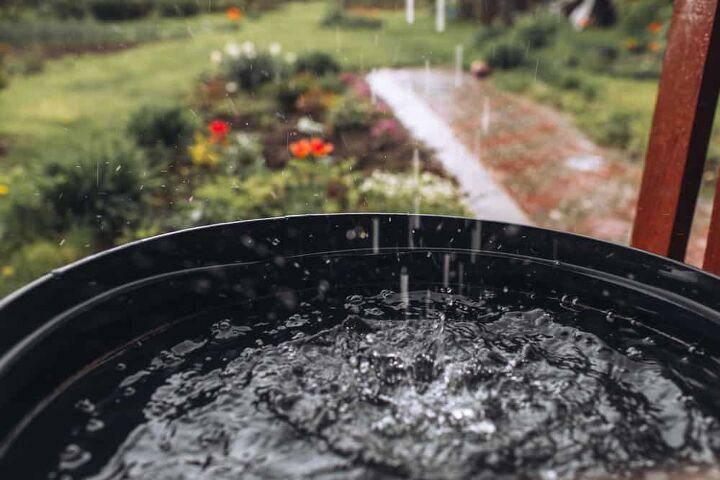How To Collect Rainwater Without Gutters (4 Ways To Do It!)

It may seem like forever ago, but it really hasn’t been all that long since the days of needing to collect rainwater for gardening and landscaping purposes. As a matter of fact, today’s homes have roof gardens that not only absorb the rain but grow insulating layers of grass as well.
You can collect rainwater without pipes if you bury a barrel in the ground and run a diverter pipe to it. Take advantage of catchment areas on your roof to collect rainwater or divert it away from your home. Tarps are another great way to collect rainwater, and you can the slope of your landscaping and pavers to channel water as well.
Gutters are a modern convenience, but luckily, there are several alternatives if you don’t have them. Follow along as we explore how you can collect rainwater even if you don’t have gutters.
Do You Need Roofing, Siding, or Gutter Installers?
Get free, zero-commitment quotes from pro contractors near you.

Why Collect Rainwater?
For the uninitiated, it may seem perplexing. Why would you collect water when our homes not only have taps but hoses built into our very homes? Well, the answer varies but there are two reasons: costs and location. Using water through your home costs money, plain and simple.
Moreover, there is a chance that you may not have a hose spigot in a convenient location to properly reach all of your landscaping. Having access to the water that you need is important for the health and growth of your plants, grass, and your landscaping in general.
Collecting Water for Landscaping Purposes
- It’s free. Yes, you have access to flowing water whenever you want it from your sink or water spigot. But that water costs. While it isn’t terribly expensive, it can be more than some are comfortable paying. Rainwater is free and, depending on the area, plentiful.
- Your plants need it. Plants generally seem to be a bit brighter and greener in the wake of a good rain. Dirt and dust get washed away and the plant gets the nutrients that it needs to thrive. Rain also contains potassium, sulfur, and a variety of minerals and microorganisms that are beneficial to plants.
- Improves soil. Rain actually gets distilled prior to the evaporation process. This means that it is perfect for diluting any salt backups that may be happening in soils. With too much salt, plants can become stunted or even die. Rainwater is a great way to improve the quality of the soil and can even accentuate the fertilizer that you have laid down.
- Replenish groundwater. Because of modern amenities and construction, groundwater has decreased, substantially in some areas. Collecting rainwater can help to replenish the groundwater in your immediate area, making the landscapes that much healthier.
- Gravity makes it easier. The great thing about collecting rainwater is that it isn’t hard. With even a barrel, you can collect a decent amount of water. But by making use of gravity and the water that falls off of roofs, for instance, you can make collection even easier.
5 Ways to Collect Rainwater without Gutters
1. Barrels
It may sound ridiculous, but barrels can be your best friend if you need to collect water but you don’t have gutters. You can either bury barrels in the ground to collect water or simply leave barrels out where the water naturally runs off. It is more expensive and takes longer to bury barrels, but that is the most effective method.
You must install pipes to divert the water towards the barrels whether they are in-ground or above-ground. However, it is okay to leave barrels above ground if you fasten them somehow and you may not need to use pipes. As long as the water has a clear path, barrels are one of the best ways to collect rainwater without gutters.
2. Tarps
Homeowners have used tarps as a way to collect rainwater instead of tarps for decades. It may not seem visually appealing, but tarps are a perfect way to divert water for collection or to simply get it away from your house. Many homeowners place barrels at the end of the tarp to collect the rainwater.
However, there are no rules and you can use tarps to lead to a rain pond or even the soil. Make sure to set your tarps up so that lead at least 10 feet away from your house. Otherwise, you run the risk of soil damage and expensive foundation damage.
3. Diverter Pipe
Install diverter pipes in your landscaping to catch and direct rainwater if you don’t have gutters. They look similar to gutters but you install them above your flower beds to divert the water. You can also install diverter pipes above doorways to divert water away from your home or landscaping.
Diverter pipes are useful to prevent water from damaging your landscaping. Without gutters, water rolls off of your roof and into the soil potentially damaging your plants. Diverter pipes prevent soil damage, foundation damage, and are easy to install.
You can even install diverter pipes right under your roof so that they act almost exactly like standard gutters. A homeowner can cut a diverter pipe to perfectly fit the space, and there is more freedom than with gutters. It is up to you whether you choose to channel the water from your divert pipe or simply collect it.
4. Catchment Area
A catchment area is a section of your roof where water naturally flows. Catchment areas are where 2 sections of a roof meet and force water to flow like a stream off of the roof. They work similarly to gutters, but their path doesn’t run the course of the entire roof.
You simply need to install a drainage pipe where the catchment area comes together to remove the water. Make sure that the pipes lead to an area far from your foundation or important soil beds. The pipe can also lead to a collection area which means you won’t waste water or damage the surrounding soil.
5. Landscaping
The best way to catch rainwater without gutters lies within your yard already: landscaping. Landscaping is what you make of it, and you can easily modify it to catch rainwater for yourself. Install pipes or create a slope in your landscaping so that water goes downward and away from your home when it rolls off of your roof.
Install pipes or dig out a slope near low-lying areas in your landscaping to direct the flow of water. You can use diverter pipes or simply dig out a subtle slope that leads to a specific area. Use pavers along the slope to make it look better and add character to your landscaping.
All About Rain Barrels
Rain Barrel Collection Yield
Having a barrel to collect rainwater is a simple yet effective way of doing so. But how much water can you expect? Not only that, how long will it take to fill up that barrel? Knowing what to expect lets you know how much you can safely use before it refills again.
- Measure your home exterior. Start by measuring the width and length of the exterior of your home as well as the roof overhang.
- Catchment area. To find out what your roof catchment area is, simply multiply the length by the width.
- Multiply by 0.6. When you get your measurement, multiply that by 0.6 The 0.6 measurement is the portion of a gallon that you can harvest for every inch of water that falls per square foot of roof.
What you are left with is how many gallons you can expect your roof catchment rea to yield from a single inch of rainfall. It is also important that you don’t leave your rain barrel uncovered. If you have small children, it can create a safety hazard. More likely, though, you will find insects and debris floating around and no one wants that.
Keeping a Rain Barrel Fresh
While rainwater barrels are highly convenient, there is a chance that it can start to smell if it sits for too long. Thankfully, there are a couple of steps that you can implement to keep the barrel fresh, clean, and odor-free.
- Shade. If possible, keep your rainwater barrel stored in a shady spot. Too much exposure to sunlight can lead to algae growth. Algae is not only gross to look at, but it can create a rather repugnant smell that is none too pleasant.
- Empty it. Once a month or so, empty out your rainwater barrel and give it a good clean. While it may seem counterintuitive to dump water you’ve collected, it is the only way to keep the barrel clean. Scrub out the entire barrel using a little bit of baking soda and water. Baking soda eliminates odor, getting rid of any funk that may be there. Finally, make sure that you wash out the entirety of the barrel, even the screen and downspout.
- Chlorine bleach. Should you notice algae forming, don’t fret. Add in a single capful of chlorine bleach when it starts to fill, or you notice algae forming. Mixed with the water in the barrel, it won’t do any harm to your plants and will get rid of the algae or prevent it from showing up.
Keeping your barrel clean is a good idea not only to prevent nasty smells but to keep the barrel sanitary as well. Try not to go too long between cleanings as the funk will only get worse with time and neglect.
Full Rain Barrels
Depending on the amount of rainfall that you get and the frequency in which you use the water, a full barrel is a possibility. If your barrel has a diverter, that diverter will shut off and the rainwater will flow out of your gutter as it normally would.
If rainfall is excessively heavy, the worst that will happen is water will overflow out of the top of the barrel even if sealed. This usually isn’t a big deal but it can lead to flooding around the area of the barrel if not addressed.
Related Guides

Ryan Womeldorf has more than a decade of experience writing. He loves to blog about construction, plumbing, and other home topics. Ryan also loves hockey and a lifelong Buffalo sports fan.
More by Ryan Womeldorf



























